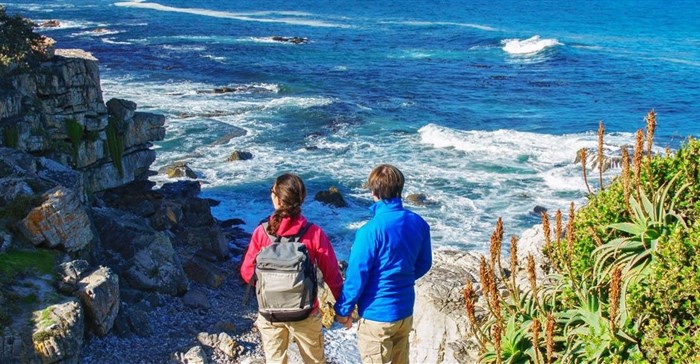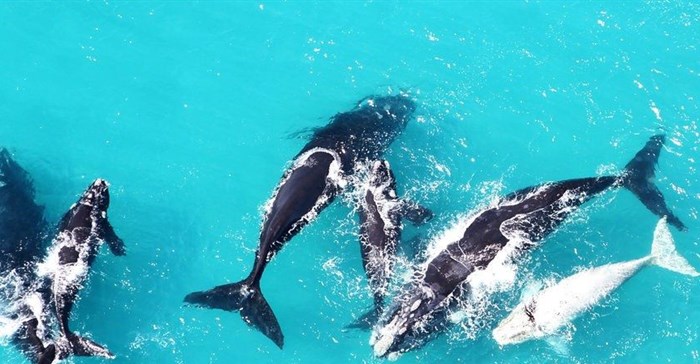






The diverse fauna and flora have become a major drawcard for nature-lovers from across the globe and there’s undoubtedly something really special to be found in the waters of the sheltered bays of Hermanus and the surrounding Cape Whale Coast towns.
It is here that the majestic southern right whale chooses to spend up to five months a year, after dutifully making the long journey from their home in the icy waters of the Antarctic. These gentle giants pass their time nursing their newborn calves and happily cavorting with each other, only metres away from the shore, providing spectacular land-based viewing opportunities for eager onlookers.
Each year the rocky clifftops embracing Walker Bay become a picturesque grandstand for thousands of local and international tourists as they vie for a chance to see these modern day giants. So much so that Hermanus makes a big splash on SA’s tourism calendar by hosting a festival to welcome and celebrate these marine mammals. The Hermanus Whale Festival is the only eco-marine festival in South Africa and is held in peak whale watching season so that everyone is guaranteed to have a whale of a time.
Recognising the southern right whale is relatively easy when you know what to look for. Not people-shy and weighing in at between 40-50 tonnes, these mammoth ocean mammals reach lengths of up to 18 metres. They have large heads covered in callosities which are rough calcified patches of skin that are unique to each whale. The patches are often used by researchers to identify individuals.

The southern right whale has no throat-grooves which mean that they can’t extend their throats while feeding, instead they use over 400 baleen plates in their cavernous mouths like a massive sieve, as they subsurface skim-feed. The dish of choice is tiny, shrimp-like crustaceans known as krill. As the whales move along with their mouths open, they first trap and then rinse these tasty morsels through the baleen and down into their stomachs which boast no less than three compartments.
Travelling at speeds of around 14 kilometres per hour they have an impressive maximum bottom time of an hour, but spend an average of four to eight minutes under water on shorter dives. On surfacing, an easily recognisable v-shaped puff of water is blown from their dual blow-holes which are unique to southern right whales.
Businesses in South Africa benefit from the over 10 million international tourists who enter the country annually, and the industry has undoubtedly become the bread and butter of South Africa's economy.
Given the importance of tourism in our economy, we must continue to nurture the resources that generate our main source of income. Educating ourselves on the sights and sounds of our country is a highly beneficial tool to maximise the visiting tourists' holiday experience. Regardless of the role they play in the business concerned, everyone from waitresses to shop assistants as well as business owners should aspire to become ambassadors for our country. Being as knowledgeable as possible on the history and biology of the things that interest our tourists is a must, especially for those of us living in what is undoubtedly the planet's wildlife- and whale-watching mecca.

Listed as endangered by CITIES (Convention for International Trade in Endangered Species), the Southern Right Whale is protected in all of its known breeding grounds. These gentle giants were mercilessly hunted until 1935 by which time the population had dwindled to an alarmingly low 300 whales. Now, they are steadily recovering, with the last tail count numbering at around 10,000 with an estimated increase of a satisfying 7% per annum.
A large area of Walker Bay has been declared a Whale Sanctuary, and from 1 July to 30 November each year, only permit holders are allowed into the Marine Protected Areas. Conserving and protecting our resources is crucial and organisations such as the Dyer Island Conservation Trust, Grootbos Foundation, African Penguin and Seabird Sanctuary and the Flower Valley Conservation Trust that proactively run projects to educate and empower the communities that live and work within them.
Xplorio works closely with all tourism bureaus and the Overstrand Municipality, with the core focus being on educating local business owners on the importance of representing themselves accurately online. Xplorio also promotes responsible tourism and recently showcased The Southern Right Whale infographic which is a must-see for nature and ocean enthusiasts.